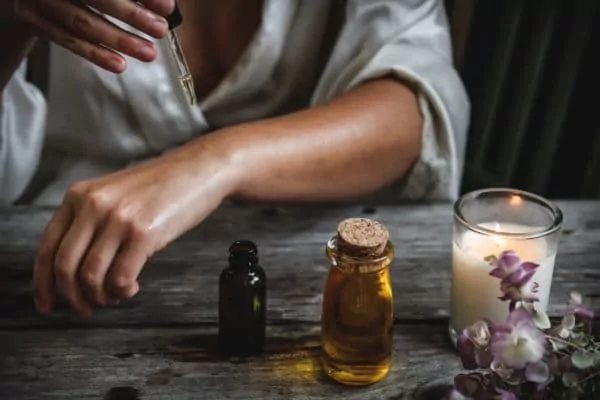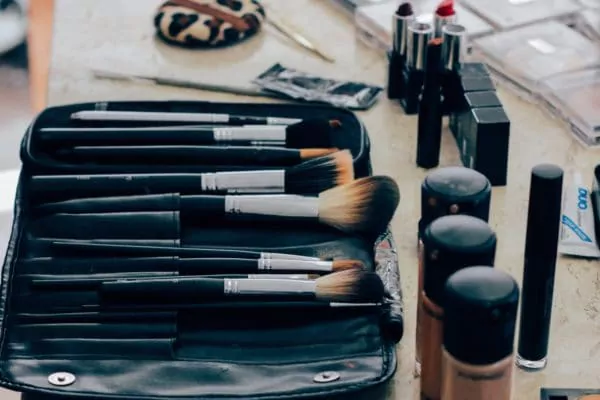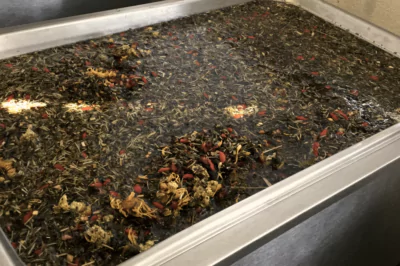Table of Contents[Hide][Show]
More often than not, I feel like the Goldilocks of the Clean Beauty movement. I find myself frequently enticed with new brands’ beautiful packaging, organic claims, and seals that prove the companies honest commitments.
However, more often then not, when I go to try them out, I look through the ingredient list and discard one after another!
Truth in labeling
With the growing list of ingredient-conscious brands, more are being developed with true integrity. True integrity, in my opinion, is present when I read the ingredients and the formulations and they match the marketing down to the last ingredient.
When you have studied ingredients for a decade you can easily read a label thoroughly and determine fact from fiction when it comes to claims on the box. This one is covered in green washing (misleading labeling) so I don’t trust the company integrity. It is hiding the toxins it does use by focusing on what it doesn’t have in it. This one would be good if it didn’t have those ingredients. On and on it goes. So few brands truly make the cut.
So, I find myself feeling a lot like Goldilocks when looking through the skin care aisle or the website of a newly launched “clean” product. When you are truly informed, it is very difficult to find more than a few product lines that are “just right”.
Demanding transparency
The bright side is, even if the majority don’t make the cut, the public’s demand for transparency has given us the ability to know what we are buying. This ultimately has resulted in the creation of a few truly amazing skincare companies!
These lines contain pure ingredients, have high integrity in business practices and deliver the results they claim. Without knowing your ingredients or trusting a person you have never met how can you find and select these brands?
How to distinguish clean beauty products from toxic ones
With many misleading, low integrity and profit-driven skin care companies out to take advantage of the growing organic beauty movement, it’s hard to know where to turn for help to clear out the confusion and clean up our products.
How is this possible? Isn’t the industry regulated? Truth be told, in the United States, it has been over 80 years since a cosmetic bill was passed. Yikes, right?
A Little History in Skin Care Regulation
The FDA passed the Federal Food, Drug and Cosmetic Act back in 1938. This Act defines cosmetics as “articles intended to be rubbed, poured, sprinkled, or sprayed on, introduced into, or otherwise applied to the human body…for cleansing, beautifying, promoting attractiveness, or altering the appearance.” Before that, cosmetics were excluded from the Pure Food & Drug Act of 1906 because they were not considered a serious public health concern.
Between 1906 and 1938 an incident linked to use of an eyeliner product motivated Congress to pass the bill we still use today, the Federal Food, Drug and Cosmetic (FD&C) Act, which expanded FDA’s authority to regulate cosmetics including the need for approval or product recall if an ingredient is found to be dangerous.
So, as of today, the word cosmetics in the regulatory bill includes all products we consider body care, skin care, and makeup. I know the FDA doesn’t regulate skin care. Under the above, it seems to state explicitly that it does. So, which is it? To clear up the confusion I went directly to the source.
Direct Quotes from FDA Website
The below quotes confirm that the FDA does not, in fact, require cosmetics be tested and approved before they get produced, nor after. The below explicitly states that it is the company’s responsibility to ensure the safety of the products manufactured and the FDA doesn’t even require the review of safety information. *facepalm*
This is the rock solid proof and reason for the public outcry around ingredients and why we have had decades of chemical-laden products filling our cabinets. I am so grateful to live in this time and be a part of this movement toward transparency and public education. This will ultimately lead to a healthier future for the cosmetic industry as a whole.
The FDA on product safety
FDA’s legal authority over cosmetics is different from our authority over other products we regulate, such as drugs, biologics, and medical devices. Under the law, cosmetic products and ingredients do not need FDA premarket approval, with the exception of color additives.”
“Companies and individuals who manufacture or market cosmetics have a legal responsibility to ensure the safety of their products. Neither the law nor FDA regulations require specific tests to demonstrate the safety of individual products or ingredients. The law also does not require cosmetic companies to share their safety information with FDA.”
The rise of “green” skin care and clean beauty
Now that we can agree without question that the skincare industry is not truly regulated. We can’t all dedicate hours of our lives to studying ingredients to know if products are healthy or toxic. To help with this, there has been a rise in trending terms to educate the public between toxic and healthy choices on the market.
The words Organic, Natural, Green, Non-Toxic and now Clean Beauty are used as a way to attract customers to the healthy products that they are seeking. However, what is the difference between these beauty industry terms and which one has the greatest benefits?
The Mystery of Product Descriptions Explained
At first glance, most of the green movement buzz words all look the same. However, they have varying definitions and meet drastically different standards. Discover the difference here to know what you should be getting when you buy a product with the following words attached to it.
[Note: I say, “should be getting” because the skincare industry is primarily self-regulated, as we learned above.]
Organic Skin Care
This term has changed over time. Organic has been used as the main indicator that a product is created with healthy ingredients. It is distinguished as one of the top quality choices. Now, a label that says organic can also mean a narrow definition that the product’s ingredients are being produced without harmful pesticides.
What does organic mean?
Companies can complete an expensive and time-intensive process to acquire an Organic Seal that proves the ingredients meet verifiable standards the public can trust. With the term USDA-Certified Organic, the product will contain at least 95% organically cultivated ingredients. With the NSF Organic-Certified, the product contains at least 70% organic ingredients.
Note that even the USDA-Certified Organic label doesn’t ensure the product is 100% pure. With this fact, though the USDA-Certified Organic label is one that ensures the majority of the ingredients are healthy, I don’t believe this is the sole indicator of quality.
The word organic is an indicator that a line has quality standards. Just remember that in the end the proof is on the label and the company’s integrity is the true test of quality. After all, it is the company’s job to ensure the safety of what’s in the product (as per the FDA regulation).
Natural Skin Care
This term lets the consumer know that the ingredients are sourced from nature and are minimally modified to keep their “natural” state as much as possible. This used to be a great term to look for on products as an indicator of your healthy options.
Many companies wrongfully use this term on their products. This will happen when only a select few of the ingredients in the product are natural. Terrible and misleading, right? So, unless you look at the label and know what you are reading, seeing this on the bottle is not a confirmed indicator that the product will be a healthy one throughout the ingredient list.
It is just too general of a term to ensure the majority of the product meets quality health standards.
Green Skin Care
Products with this label are letting you know that they were developed with a focus on limiting the environmental impact of their sourcing and creation. This can include ingredients in the bottle as well as the packaging and manufacturing processes. The greenest companies think through how their product affects the land. This refers to the growth, harvesting, manufacturing process, how those actions influence the Earth and populations around it, as well as the packaging materials and post-consumer impact.
A lot goes into this label. Many companies simply claim their products come in recyclable packaging and label their products green. There are many more steps for a product to be labeled truly green in my opinion.
Pay close attention to this claim and what the company is actually doing that makes it “green.”
Clean Beauty
The latest buzz in the skincare industry is clean beauty. Many brands have used all of the above terms and applied them to sell their products. Though there is not much to back up their claims. A new label has hit the scene to further educate the public, create a standard to back up the claim and help clear up the misleading labeling (also known as greenwashing).
Clean beauty signifies that a product doesn’t contain “dirty” ingredients (natural or synthetic) that are considered unsafe. Another term for clean beauty is non-toxic. Since some plants and natural ingredients can be toxic, this change in terminology focuses on the effect the product will have more than the ingredients themselves.
I believe this new approach will become the primary term we see in the skin and cosmetic industry from now on.
The Truth About the Toxic Shampoo Industry (And 11 Reasons Why You Will Love Clean Hair Care)
What your need to know about clean beauty
The lists of dirty ingredients for the clean beauty movement vary pretty dramatically. Sephora’s latest CLEAN seal pledges that products with that seal don’t contain their list of 13+ dirty ingredients, then there is the “dirty dozen” (12) and “dirty 30” many other companies adhere to as their quality standard. This is all wonderful!
Also, let’s compare this to the EU who’s cosmetic database bans 1,382 chemicals to date. I have looked at this list, it is public. I have linked it below if you want to check it out.
Eurpoean Standards
I have known, for years, Europe has a better policy around ingredients. I went to Europe on 2 different occasions, exploring spas and pharmacies within 4 different countries. My goal was to seek a new incredible product line to bring back to my clients. Do you know what I discovered? It is not easy to find truly pure clean products there either!
In the end, the skin care I use at Embody Zen would rival anything and everything I found in Europe (Disagree? Prove it to me and send me links to European lines. I would love to see more quality skin care in the world). I’m still excited to explore beyond Europe to Australia and New Zealand one day.
I am very happy with the current products, ingredients, results, and integrity of the companies that I incorporate into Embody Zen in the meantime. You finding this article means you are also on the right track or already in the know. Great job educating yourself and getting here!
THE FUTURE OF CLEAN BEAUTY
I predict that the skincare industry will eventually have a universal “clean beauty score.” The top score will only be attainable if green, clean and organic standards are all met. This is the future of the cosmetic industry I see. In the meantime, clean beauty, with its commitment to public awareness and removal proven toxic ingredients from our products, is a leap forward.
One last note of advice as you clean your beauty routine. Truly clean is not only what a product doesn’t have in it. Clean Beauty is about company integrity above all else. As the list of toxins on the “dirty list” grows, make sure that your investing in companies that are willing to go through the costly process of removing products from shelves and reformulating to ensure they keep meeting the clean beauty standard, ensuring your safety is the most important thing.
Top 10 Benefits of Clean Beauty
We know clean beauty is important but what are the actual reasons to go through all the trouble to change products? Here are 10 amazing benefits of clean beauty and why its definitely worth the effort!
- Prioritizes the safety of ingredients.
- Bans a list of Irritants and allergens. (linked to eczema, rosacea, contact dermatitis)
- Lowers your risk of irritation, redness, and sensitivity.
- Bans a list of Potential Carcinogens. (linked to cancer)
- Lowers your risk of cancer.
- Bans a list of Potential endocrine disruptors. (linked to hormonal imbalances, infertility)
- Lowers your risk for hormonal dysfunction.
- Lowers your body toxicity. (linked to decrease in your daily chemical exposure)
- Enhance immunity. (healthy skin is directly linked to a healthy immune system)
- Enhance overall health and wellbeing. (skin health is linked to mental health as well as physical health = taking care of your skin can enhance mental and physical wellbeing)
To me, clean beauty is more than skin deep. It is a way of life and beauty is one part of an overall clean lifestyle. The food industry is evolving with more organic, clean and farm fresh products.
The Truth About the Toxic Shampoo Industry (And 11 Reasons Why You Will Love Clean Hair Care)
References:
FDA Authority Over Cosmetics: How Cosmetics Are Not FDA-Approved, but Are FDA-Regulated
Federal Food, Drug, and Cosmetic Act
EU LIST OF SUBSTANCES PROHIBITED IN COSMETIC PRODUCTS
The Real Meaning of Clean Beauty, According to Scientists
What does your immune system do for your skin?
Clean cosmetics: The science behind the trend
CLEAN BEAUTY: THE BENEFITS OF USING NATURAL SKIN CARE PRODUCTS
Senator decries “poisons” as unregulated chemicals in cosmetics draw scrutiny
CLEAN at SEPHORA
Raising the bar of Clean Beauty
What is ‘clean beauty’? Here’s what you need to know










Besides AnnMarie Gianni, I’d sure like to know which company and products this writer recommends and which one’s to avoid.